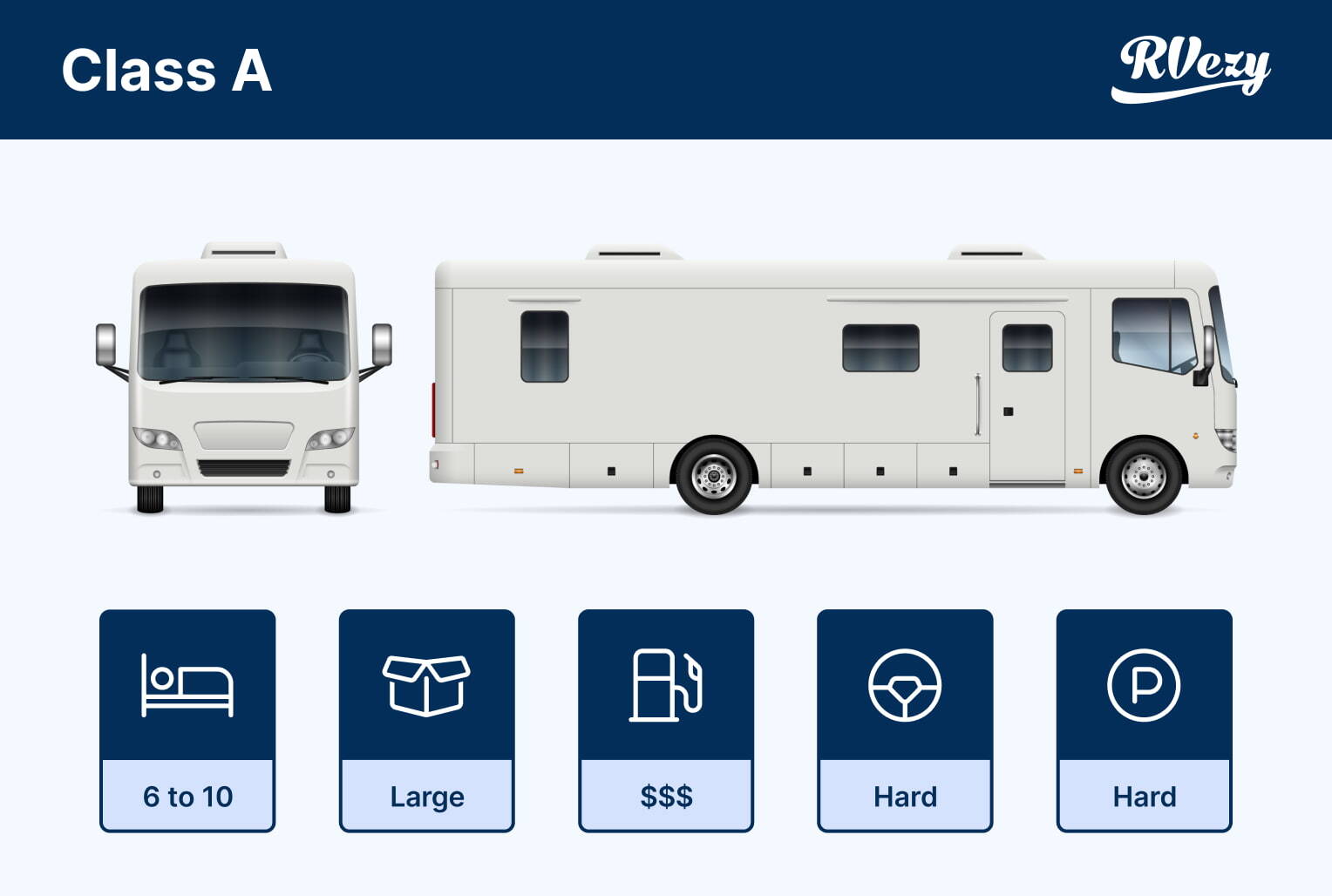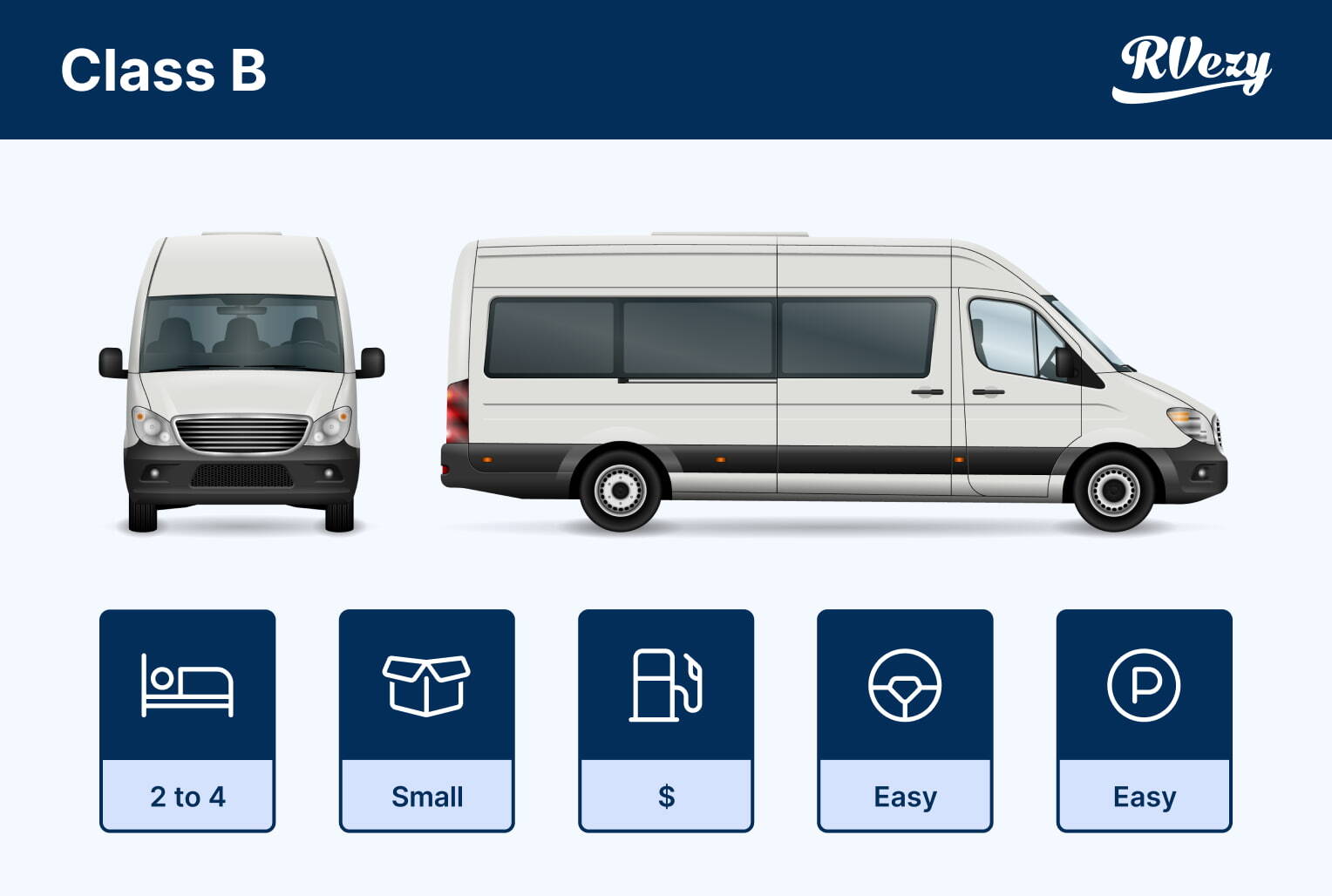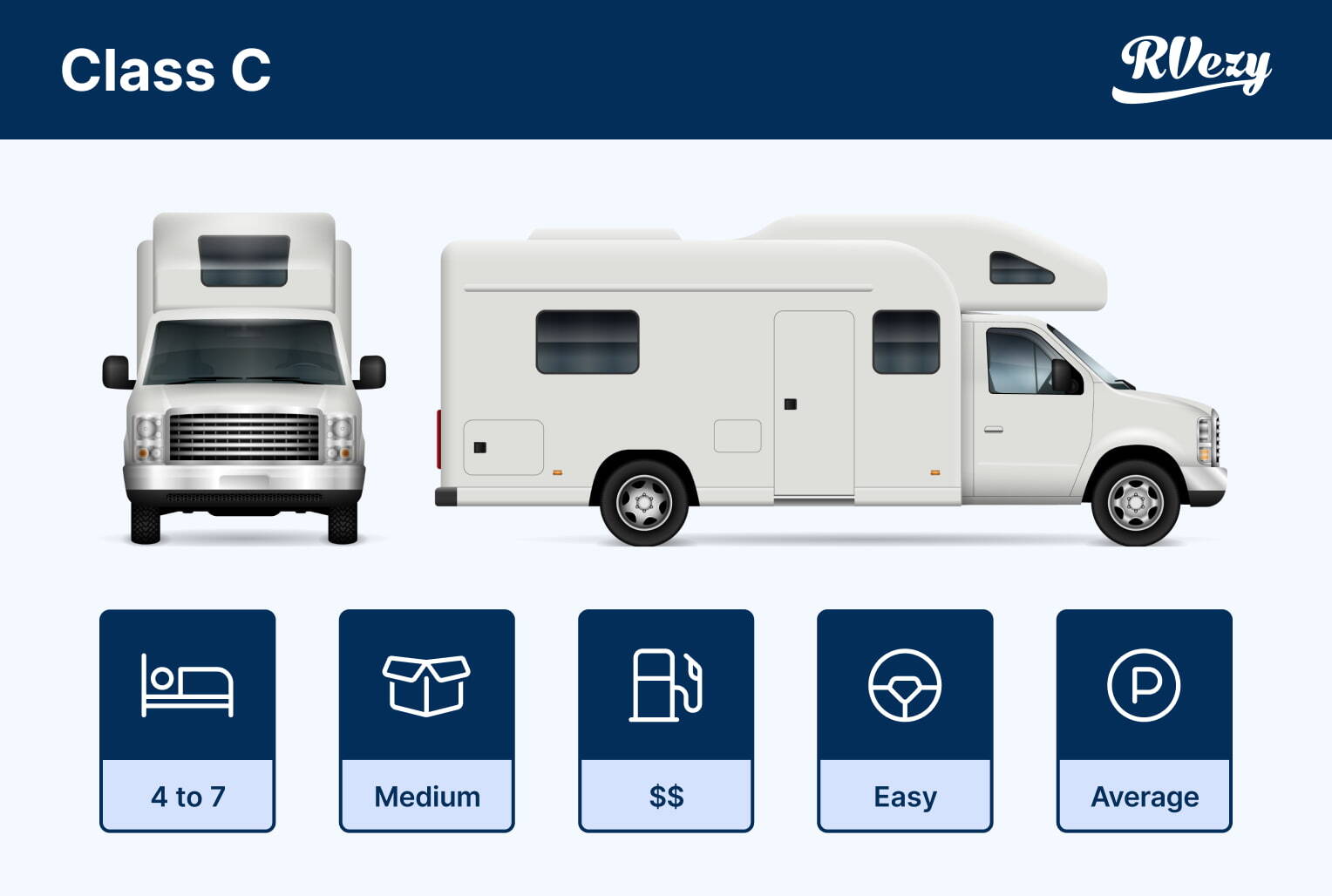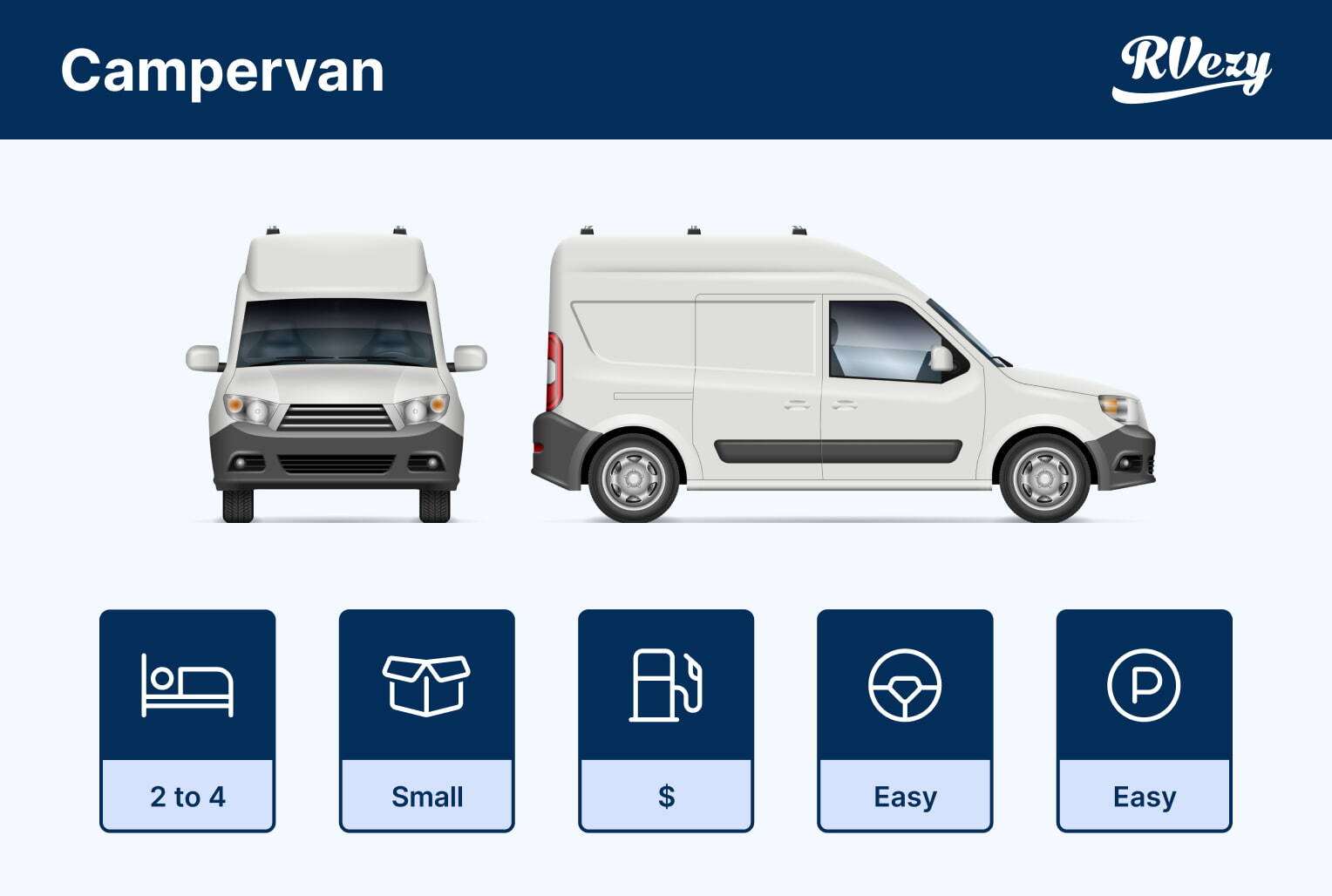![RV Classes: A Visual Guide For RV Beginners [2024]](https://ghost-cdn.rvezy.com/2022/09/final-rvezy-rvtypes-header.png)
Do you ever wonder why some RVs have a class, and others don't?
You're not alone.
In this article, we explain everything you need to know about RV classes (and unofficial classes) and clear up the common misconception that RV classes and RV types are the same.
Let's get started.
Already know the difference between RV class and RV type? Jump ahead or read on for more information.
What's the difference between RV class and RV type?
RV class
Motorhomes (drivable RVs with engines) are the only recreational vehicles assigned a classification. The RV industry uses the word class because it's a shorter way to say classification.
RV type
An RV type is a subcategory that comes from either an RV class or another grouping of vehicles that share similar structural or physical characteristics. RV types include motorhomes, travel trailers, truck campers, and more.
Towable RVs, which require a separate tow vehicle, include various types such as fifth wheel trailers and travel trailers.
Fifth wheel trailers are known for their spaciousness, comfort, and amenities, making them a popular choice for those seeking a home-like experience on the road.
Travel trailers, on the other hand, come in different sizes and features, making them suitable for families and easy to set up and tow.
Want to know more about RV types? Check out The 9 Different Types of RVs [Pros and Cons].
What are the 3 RV classes?
All motorized RVs are classified according to their chassis. The chassis is the load-bearing framework manufacturers use to build the motorhome and give it the characteristics we recognize on the road and in the campground.
Motorhomes fall under one of the following classifications: Class A, Class B, or Class C. Class B motorhomes and Class C RVs are among the main classifications, each offering unique benefits for different needs and preferences.

Class A
Class A motorhomes look like a bus and are the biggest drivable RVs. You can choose from either a gas-engined or diesel-engined (sometimes called a diesel pusher) Class A. Depending on the length and weight, Class A motorhomes can have either a single or dual (tag) rear-wheel axle. Class As are often considered the most luxurious RVs on the market.
Sleeps: six to ten people.
Storage space: large.
Average fuel economy: 7 to 13 mpg (18 to 34 L/100 km).
Driving difficulty: hard.
Parking difficulty: hard.
Did you know that most RVs don’t require a special license to operate? We break down driver’s license requirements for the United States and Canada.

Class B
Class B motorhomes look like a van and are the smallest drivable RVs. Class B vans come with either a gas or diesel engine and vary in length. Like most motorhomes, you'll find the longer rigs with heavier components built on a diesel chassis. Class B RVs are small and ideal for solo RVers or couples looking for memorable adventures.
Want to learn about Class B subclasses? Jump to Class B Plus and Campervans.
Sleeps: two to four people.
Storage space: small.
Average fuel economy: 18 to 25 mpg (9 to 13 L/km).
Driving difficulty: easy.
Parking difficulty: easy.

Class C
Class C motorhomes are the most recognizable RVs on the road. Class C rigs have a bunk over the cab and are built on a gas-engined cutaway truck or van chassis. Class Cs come in different lengths, typically 21 to 41 feet long, and because of their various sizes, you can find a Class C to take you just about anywhere. Class C RVs are a popular choice for families and groups due to their size and amenities.
Jump to Super C to learn more about diesel-engined Class C motorhomes.
Sleeps: four to seven people.
Storage space: medium.
Average fuel economy: 14 to 18 mpg (13 to 17 L/km).
Driving difficulty: easy.
Parking difficulty: average.
What are the RV subclasses?
The RV community loves to use acronyms and nicknames, so it's no surprise that RVers have turned the words campervan, Class B+, and Super C into unofficial RV subclasses. These subclasses of RVs are so recognizable that even RV dealers and manufacturers use these terms.

Campervan
What's the difference between a campervan and Class B RV? Nothing. The name campervan describes anything from a manufacturer-built van to a DIY conversion van. Sometimes the name campervan signifies a smaller Class B with fewer amenities but not always.
Sleeps: two to four people.
Storage space: small.
Average fuel economy: 18 to 25 mpg (10 to 13 L/km).
Driving difficulty: easy.
Parking difficulty: easy.

Class B Plus
If you want an interior similar to a Class C but prefer a Class B maneuverability, then a Class B Plus (B+) might be for you. A Class B+ has a similar profile to a Class C, except the over-cab area doesn't have extra sleeping space. Instead, the over-cab area in a Class B+ has entertainment components or extra storage. In addition, class B+ RVs can have gas or diesel engines, and because of the chassis, the B+ can handle more weight for slide outs and luxurious interior components.
Sleeps: two to four people.
Storage space: medium.
Average fuel economy: 14 to 25 mpg (10 to 17 L/km).
Driving difficulty: average.
Parking difficulty: average.

Super C
The Super C is bigger and beefier than the Class C motorhome because it's built on a diesel-engined truck chassis. Super C RVs look like semi trucks from the front and RVs in the back. Their powerful engines allow for heavier components and more slides and storage than a regular Class C motorhome.
Sleeps: four to seven people.
Storage space: large.
Average fuel economy:14 to 18 mpg (13 to 17 L/km).
Driving difficulty: hard.
Parking difficulty: hard.
Conclusion
Now that you know the difference between the RV classes, it's time to decide which RV is right for you. If you're still unsure, try renting an RV to see which class or type of RV you like best.
Search motorhomesIn the meantime, check out some of our other helpful articles for more RV content and road-trip inspiration.
